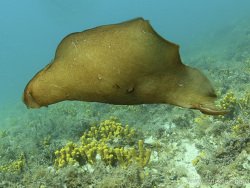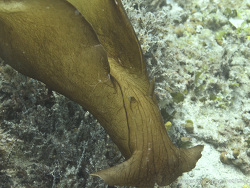Info
Aplysia depilans Gmelin, 1791
Aplysia depilans feeds on algae, including Ulva lactuca, Hypnea musciformis,Cystoseira barbata and Enteromorpha sp.
Biota > Animalia (Kingdom) >Mollusca (Phylum) > Gastropoda (Class) > Heterobranchia (Subclass) > Opisthobranchia (Infraclass) > Anaspidea (Order) > Aplysioidea (Superfamily) > Aplysiidae (Family) > Aplysia (Genus)
Sea hares feed on algae. They eat various types of algae, kelp and seaweed. In the process, plant parts are rasped off with the rasping tongue (radula). Microscopic food particles are also ingested with the algae. They are often used in aquaristics for algae problems, but with the end of their food they also get nutritional problems.
For protection against predators there are some species that additionally store the toxin aplysiatoxin. This aplysiatoxin is a product of cyanobacteria, which grow on certain types of seaweed. These are ingested along with the algae.
Sea hares are good algae eaters after a usually difficult acclimation period and are also not very picky about the algae. When acclimating, be sure to use the droplet method, as they are extremely sensitive to density fluctuations.
Thus, in addition to the usual filamentous algae, Wrangelia argus and so-called smear algae are often not spurned.
If no more algae are present, then it does not take long and the lumpfish starves to death.
However, you can also offer it over-scalded lettuce as a substitute food, but then you should also look for a substitute home.
Attention, important:
If you want to keep lumpfish, be sure to provide shelter so they don't get caught in a flow pump and shredded.
Dying lumpfish are capable of causing the entire fish and crustacean population to die within a short period of time.
If the dead lumpfish is not discovered in time, it is imperative to perform a very generous water change and additionally filter with charcoal to filter out the released toxins
Aplysia depilans feeds on algae, including Ulva lactuca, Hypnea musciformis,Cystoseira barbata and Enteromorpha sp.
Biota > Animalia (Kingdom) >Mollusca (Phylum) > Gastropoda (Class) > Heterobranchia (Subclass) > Opisthobranchia (Infraclass) > Anaspidea (Order) > Aplysioidea (Superfamily) > Aplysiidae (Family) > Aplysia (Genus)
Sea hares feed on algae. They eat various types of algae, kelp and seaweed. In the process, plant parts are rasped off with the rasping tongue (radula). Microscopic food particles are also ingested with the algae. They are often used in aquaristics for algae problems, but with the end of their food they also get nutritional problems.
For protection against predators there are some species that additionally store the toxin aplysiatoxin. This aplysiatoxin is a product of cyanobacteria, which grow on certain types of seaweed. These are ingested along with the algae.
Sea hares are good algae eaters after a usually difficult acclimation period and are also not very picky about the algae. When acclimating, be sure to use the droplet method, as they are extremely sensitive to density fluctuations.
Thus, in addition to the usual filamentous algae, Wrangelia argus and so-called smear algae are often not spurned.
If no more algae are present, then it does not take long and the lumpfish starves to death.
However, you can also offer it over-scalded lettuce as a substitute food, but then you should also look for a substitute home.
Attention, important:
If you want to keep lumpfish, be sure to provide shelter so they don't get caught in a flow pump and shredded.
Dying lumpfish are capable of causing the entire fish and crustacean population to die within a short period of time.
If the dead lumpfish is not discovered in time, it is imperative to perform a very generous water change and additionally filter with charcoal to filter out the released toxins







 Gilles Cavignaux, Frankreich
Gilles Cavignaux, Frankreich

























